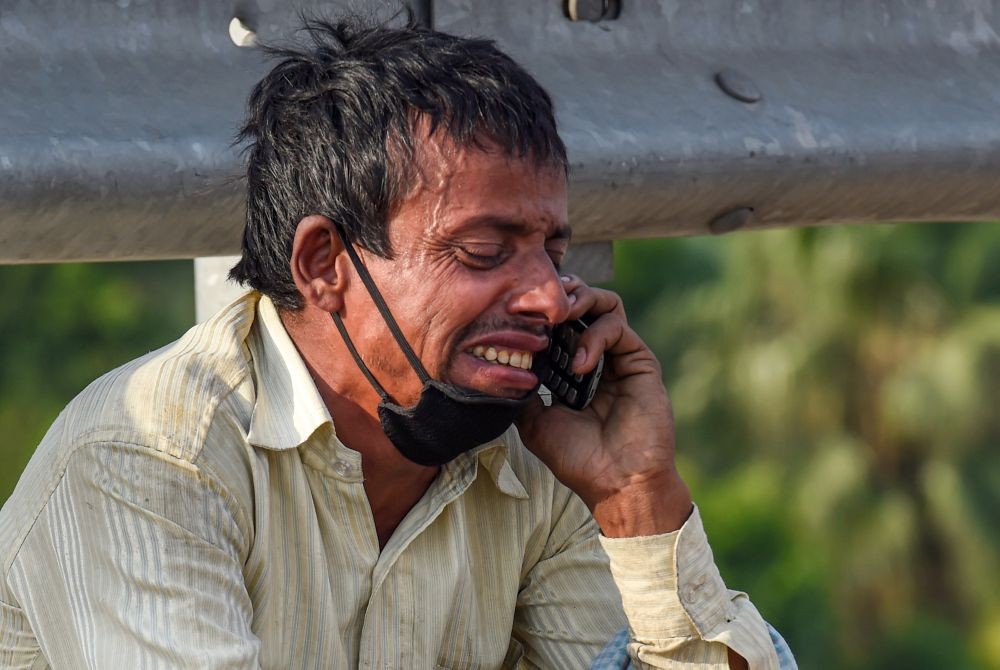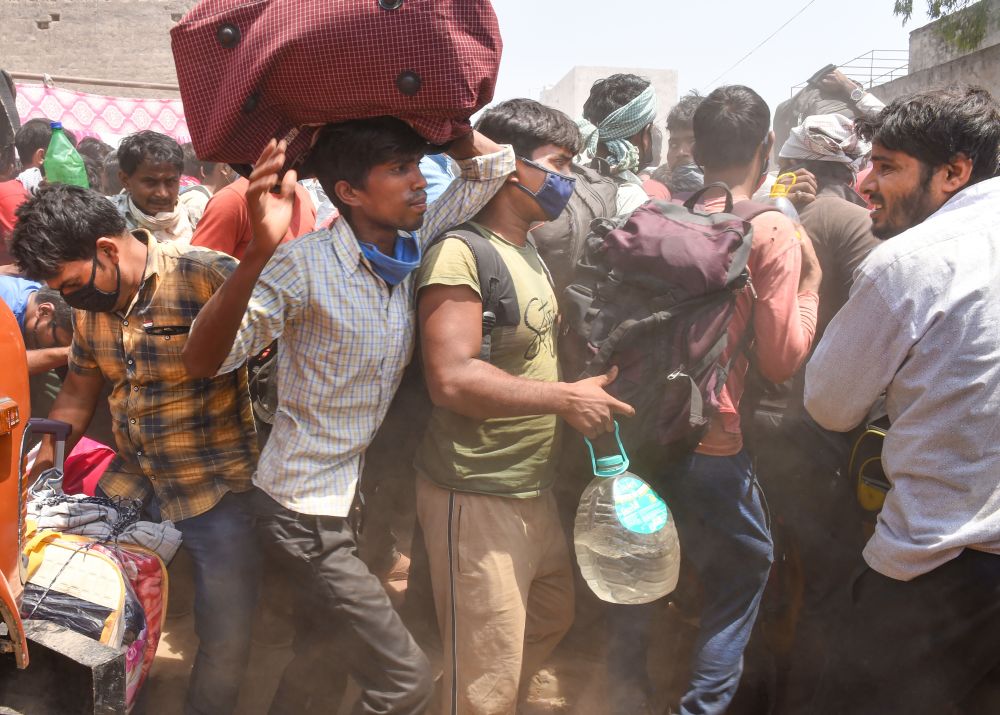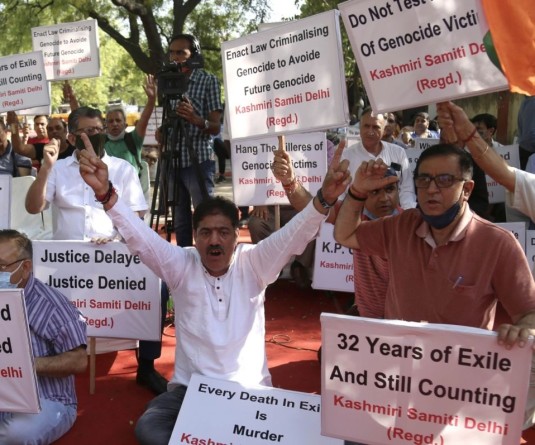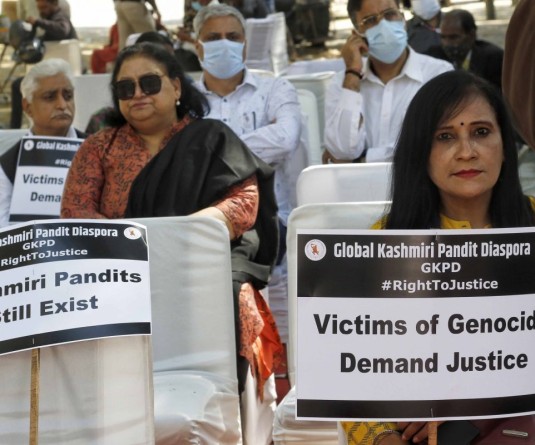* New Delhi: A migrant labourer reacts while talking to a relative over his mobile phone, at Nizamuddin Bridge in New Delhi, Monday, May 11, 2020, during ongoing COVID-19 lockdown. (PTI Photo/Atul Yadav)

New Delhi, March 25 (PTI) Its recovery from the depths of the lockdown-induced recession was swifter than expected but a surge in coronavirus cases is threatening to hurt the Indian economy which is expected to grow at 11 per cent in 2021-22.
Exactly a year back, the government imposed what is touted as the world's most stringent lockdown to contain the spread of the pandemic. The lockdown brought the economy to a halt as factories were shut, trains were stopped and flights were suspended.
This sent the economy into its worst-ever contraction of 24.4 per cent in the June quarter, followed by a -7.3 per cent shrinkage in July-September, pushing the economy into a rare recession.
However, the economy's rebound was better than expected, with GDP surpassing its pre-pandemic level in the December quarter, growing 0.4 per cent year-on-year.

Dadri: Migrant workers, lodged at a camp by the Uttar Pradesh government, rush to board a bus during ongoing COVID-19 lockdown, at Dadri in Gautam Buddha Nagar district, Wednesday, May 20, 2020. A stampede like scene was witnessed for few minutes after a rumour regarding a bus carrying them to railway station for a special train. (PTI Photo/Atul Yadav)
The rebound led to ministers predicting a sharp 'V-shaped' recovery.
But the surge in coronavirus cases, despite the rollout of a nationwide vaccination drive, in recent weeks could hurt the recovery.
Unlike other COVID-hit regions like Europe, India has so far been reluctant to impose any more harsh restrictions.
In many countries including India, second or third COVID wave has led to partial or localised lockdowns delaying the pace of recovery, said D K Srivastava, Chief Policy Advisor, EY India.
"It is the rate at which the population gets a vaccination cover, which will determine the performance of the economy in FY22. Fortunately, for India, the rate of vaccination is gathering momentum and a strong growth supporting fiscal policy has also been put in place through Centre's FY22 budget. The expectation is that India would show one of the largest bounce backs in the growth rate in FY22," he said.
Echoing similar views, ICRA Principal Economist Aditi Nayar said "COVID-19 infection counts have risen in many Indian states in recent weeks, spurring fresh localised restrictions. If this trend proliferates, it would temper the extent of the base effect-led recovery anticipated in the immediate term, and may lead to some supply-side disruptions."
At this point, business confidence is improving significantly and it seems that we will be on track towards growth despite COVID and businesses have realised that we must learn to live with COVID and its impact as we fuel the economy for growth, said L Viswanathan, Partner at Cyril Amarchand Mangaldas.
To mitigate the impact of COVID-19 pandemic on the economy, the government and the RBI came out with a series of packages in a phased manner totalling around Rs 30 lakh crore or 15 per cent of India's GDP.
Steps taken by the government to deal with COVID pandemic are resulting in a 'V-shaped' economic recovery and the country is likely to witness double digit growth in 2021-22, Minister of State for Finance Anurag Singh Thakur said in Lok Sabha last week.
He said the government focused on saving lives during the pandemic without bothering about the fiscal deficit.
In the next fiscal, the Budget has earmarked Rs 35,000 crore for vaccination and the government has assured to provide more if needed.
"The GST collection in the last five months was continuously more than Rs one lakh crore... Because of the steps taken by the government during COVID-19, V-shaped economic recovery is happening. And world over, agencies have stated India will witness double digit growth in 2021-22," he had said.
Soon after the pandemic hit the country, the government in March 2020 announced a Rs 1.70 lakh crore Pradhan Mantri Garib Kalyan Yojana (PMGKY) to protect the poor and vulnerable from the impact of health crisis and lockdown. Other relief measures were to the tune of Rs 22,000 crore.
It was followed by the Aatmanirbhar Bharat Abhiyan package in May 2020 largely focussed on supply-side measures and long term reforms. The five-part stimulus package announced by Finance Minister Nirmala Sitharaman beginning May 13, 2020 comprised Rs 5.94 lakh crore in the first tranche that provided credit line to small businesses and support to shadow banks and electricity distribution companies.
The second tranche included free foodgrain for stranded migrant workers for two months and credit to farmers, totalling Rs 3.10 lakh crore. Spending on agri infrastructure and other measures for agriculture and allied sectors in the third tranche totalled to Rs 1.5 lakh crore.
The fourth and fifth tranches that dealt mostly with structural reforms, including relaxation of Foreign Direct Investment (FDI) limit in defence, privatisation of six more airports, and fully opening up coal mining to the private sector.
To boost consumption during the festival season, the government October, 2020 announced measures of close to Rs 73,000 crore to stimulate consumer spending in an effort to rein in slowdown due to the COVID-19 pandemic.
Aatmanirbhar Bharat Abhiyan 3.0 unveiled in November 2020, ahead of Diwali, was Rs 2.65 lakh crore. Of the total, the maximum of Rs 1.45 lakh crore was allocated to give a boost to manufacturing, followed by Rs 65,000 crore for agriculture (fertiliser subsidy), and Rs 10,200 crore for industrial infrastructure, incentives and domestic defence equipment.
On its part, RBI made liquidity infusion to the tune of Rs 12,71,200 crore into the Indian economy battered by COVID-19 pandemic till October 2020.
All the stimulus measures since March 2020 by the Centre and Reserve Bank of India put together were to the tune of Rs 29,87,641 crore.
As a result of all these measures and decline in COVID infection, the economy is showing green shoots and a positive growth of 0.4 per cent in the third quarter of the ongoing financial year is an indication of rebound. However, the economy in the current year is estimated to contract by 8 per cent on account of the COVID pandemic.






